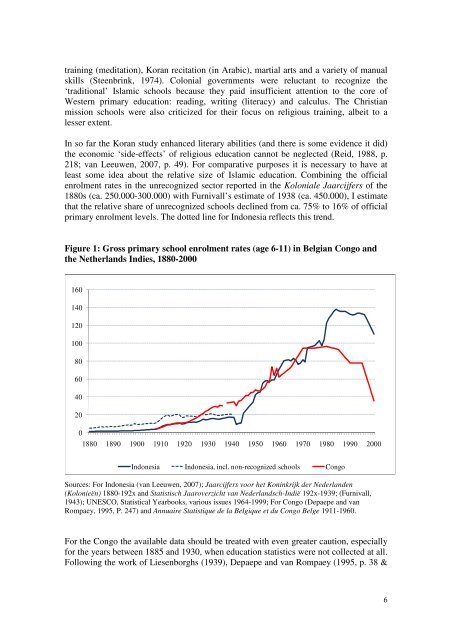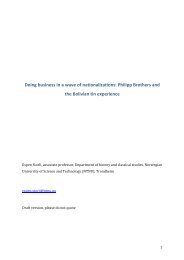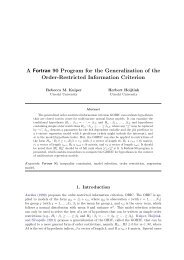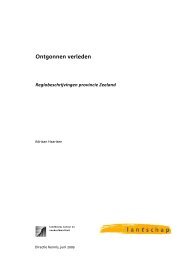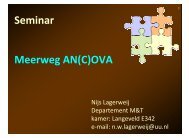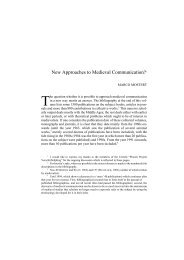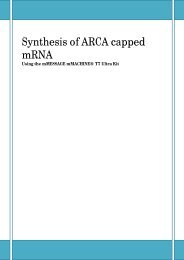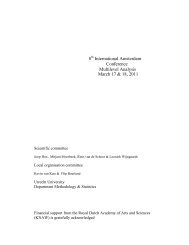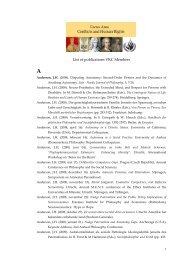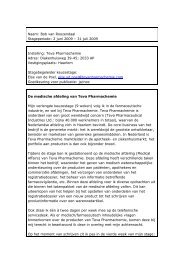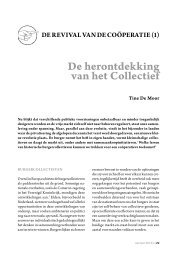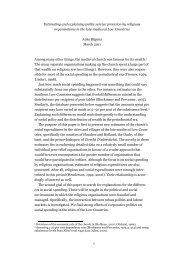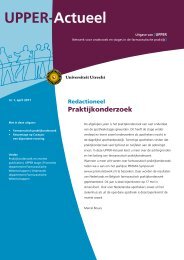the Dutch colonial government started to annex the mission schools that were unable tostay in business (Hartgerink, 1942).The Dutch thus embarked on a path towards a dual system of public <strong>education</strong>, in whichthe mission schools were tying up the loose ends and the Islamic schools were graduallyoutcompeted. 1 In this dual system European schools offered the standard Dutchcurriculum to children of European and Indo-European descent. These schools wereopen to the top layer of the Indonesian elites who closely cooperated with the Dutch.European schools prepared children for a career in the colonial administration andoffered access to higher <strong>education</strong> in the Netherlands. The public schools for thecommon people (Volksscholen) served as a basic and cheap alternative to Western<strong>education</strong> (Brugmans, 1938, pp. 302-317; Lelyveld, 1996), with the purpose to prepareIndonesians for a position in Indonesian society. As of 1907 the government launched acampaign to promote the development of village schools, the so-called desa schools,which became the major driver of enrolment rates between 1907 and 1940. Studentsenrolled in a program of three years primary <strong>education</strong> focusing on the elementaryprinciples of reading, writing and calculation in the vernacular. Possibilities to attain astandard vernacular curriculum of six years were gradually enlarged (Boone, 1996).In sum, the key similarity in the genesis of both colonial <strong>education</strong> systems was that itresponded to a growing call in European media and public opinion to ‘develop’ insteadof ‘exploit’ the overseas territories. And as we will see in the next section, it also clearlyresponded to a growing desire among the indigenous populations to acquire usefulknowledge, improve material living standards and explore new job opportunities. Thekey difference is twofold. First, contrary to the Belgians the Dutch were committed tosecular <strong>education</strong> forced by local conditions (Islam) and domestic political ideology(Schoolstrijd). Second, indigenous access to Western <strong>education</strong> in the Dutch East Indieswas very limited, but nevertheless slowly extended until independence. In the BelgianCongo the maintenance of racial segregation policies made it impossible for the childrenof the Congolese elites to engage in a full curriculum of modern primary, secondary andtertiary <strong>education</strong>.3. Comparing school enrolment rates, 1900-2000A comparison of school enrolment rates at the primary and post-primary levels providesdeeper insight in the effects of different <strong>education</strong>al policies on the expansion of<strong>education</strong>al access. Figure 1 shows the 20 th century evolution of gross primary schoolenrolment rates for the age group of 6-11 (the official school age in the postwar era inIndonesia and the Congo). The time-series for the Netherlands Indies are taken from vanLeeuwen (2007, pp. 264-6). These include the enrolment of Indonesians, Europeans(mainly Dutch) and other Asians (mainly Chinese), but exclude the children enrolled inthe unrecognized schools, which did not receive state subsidy. The bulk of theseunrecognized schools consisted of Islamic boarding schools (pesantren) and mosqueschools (madrasah). These schools offered classes in religious philosophy and spiritual1 In the first decade of the 20 th century the colonial government deliberately transferred part of its<strong>education</strong>al responsibility to the missions in some of the Outer Areas, such as the Moluccas, under thepromise of state subsidies (Hartgerink, 1942, pp. 141-149).5
training (meditation), Koran recitation (in Arabic), martial arts and a variety of manualskills (Steenbrink, 1974). Colonial governments were reluctant to recognize the‘traditional’ Islamic schools because they paid insufficient attention to the core ofWestern primary <strong>education</strong>: reading, writing (literacy) and calculus. The Christianmission schools were also criticized for their focus on religious training, albeit to alesser extent.In so far the Koran study enhanced literary abilities (and there is some evidence it did)the economic ‘side-effects’ of religious <strong>education</strong> cannot be neglected (Reid, 1988, p.218; van Leeuwen, 2007, p. 49). For comparative purposes it is necessary to have atleast some idea about the relative size of Islamic <strong>education</strong>. Combining the officialenrolment rates in the unrecognized sector reported in the Koloniale Jaarcijfers of the1880s (ca. 250.000-300.000) with Furnivall’s estimate of 1938 (ca. 450.000), I estimatethat the relative share of unrecognized schools declined from ca. 75% to 16% of officialprimary enrolment levels. The dotted line for Indonesia reflects this trend.Figure 1: Gross primary school enrolment rates (age 6-11) in Belgian Congo andthe Netherlands Indies, 1880-20001601401201008060402001880 1890 1900 1910 1920 1930 1940 1950 1960 1970 1980 1990 2000Indonesia Indonesia, incl. non-recognized schools CongoSources: For Indonesia (van Leeuwen, 2007); Jaarcijfers voor het Koninkrijk der Nederlanden(Kolonieën) 1880-192x and Statistisch Jaaroverzicht van Nederlandsch-Indië 192x-1939; (Furnivall,1943); UNESCO, Statistical Yearbooks, various issues 1964-1999; For Congo (Depaepe and vanRompaey, 1995, P. 247) and Annuaire Statistique de la Belgique et du Congo Belge 1911-1960.For the Congo the available data should be treated with even greater caution, especiallyfor the years between 1885 and 1930, when <strong>education</strong> statistics were not collected at all.Following the work of Liesenborghs (1939), Depaepe and van Rompaey (1995, p. 38 &6


